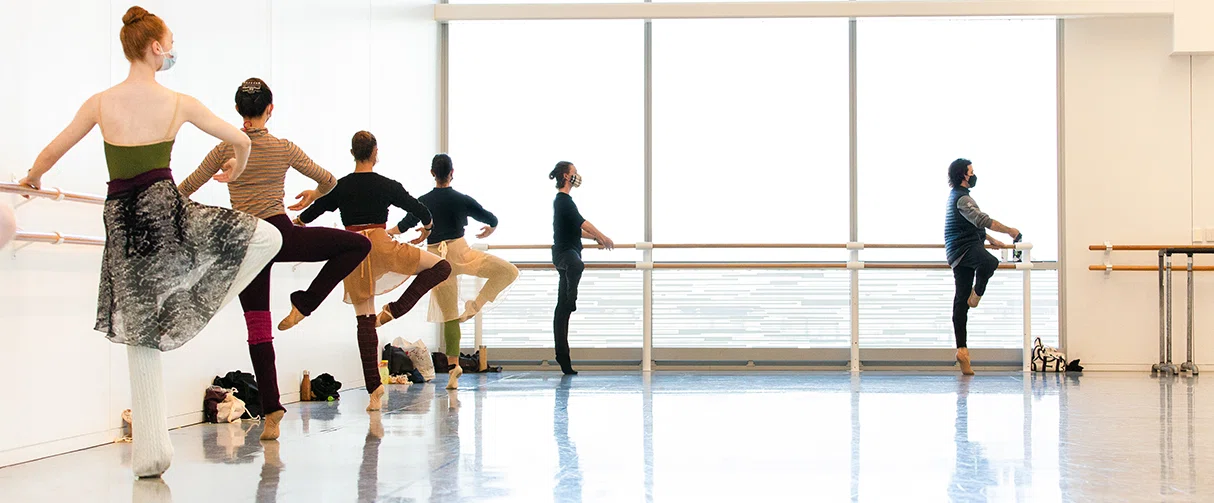


Outcomes Research
Bone Health in Elite Dancers

A study by investigators at Houston Methodist into stress fractures among elite, professional ballet dancers
Artists of Houston Ballet
Photo by Lawrence Elizabeth Knox (2021). Courtesy of Houston Ballet.
If you’ve ever been to the ballet and watched the dancers glide across the stage, twirling and lifting, leaping and tiptoeing, you know it is a thing of grace and beauty.
But before that grace and beauty is perfected comes years of practice, and with that, falls and injuries.
Ballet training adds significant stress on the musculoskeletal systems, and stress fractures are common among elite ballet dancers. Overtraining and overuse are the primary factors contributing to these fractures.
Because professional dancers often begin their career before their bones reach peak maturation age, it is important dancers follow proper precautions to reduce their chances of injury. Proper nutrition, training, and screening are crucial for promoting best performance and injury prevention as overtraining and poor nutrition affect bone development.
A team of investigators led by Patrick McCulloch, MD, John S. Dunn Chair in Orthopedic Surgery, associate professor of clinical orthopedic surgery, studied professional male and female ballet dancers to determine their bone health in relation to stress fracture history, body composition, eating disorder risk and blood biomarkers and compare those findings to other lean athletes and the general population. The intent of this study was to see how the bone mineral density (BMD), body composition blood biomarkers, and nutritional habits of professional dancers compared to that of the general population. Only a single professional ballet company was observed for this study. The findings were published in Medicine & Science in Sports & Exercise.

Professional ballet dancers are exposed to a high level of physical stressors, which is of concern because bone-stress related injuries have been observed with greater frequency in athletic activities that emphasize leanness, especially in women. This study shows dancers have higher levels in BMD in the extremities, but lower levels in the spine and pelvis.

Patrick McCulloch, MD
John S. Dunn Chair in Orthopedic Surgery
Associate Professor of Clinical Orthopedic Surgery
Houston Methodist
Investigators observed 112 dancers – 55 males and 57 females between the ages of 24-31 years. All participants underwent bone and body composition measures using dual-energy X-ray absorptiometry (DEXA). From a subset of 59 participants, a blood panel, disordered eating screen, menstrual history, and stress fracture history also were collected.
The results showed both men and women dancers were below the third percentile for body fat, and relative to age- and sex-matched population norms, in the 10th percentile for regional fat mass distribution.
Both male and female dancers were found to have BMD measures above average compared to the general populations for arms and legs, but the study showed professional female ballet dancers have below average BMD in the spine and pelvis compared to the general population. However, of the 38 dancers who were scanned and found to have low BMD in the pelvis, met the criteria for low BMD in the greater and lesser trochanter, femoral neck and head, public bone and ischium. In the forearm, four of the six of the dancers were found to have borderline criteria for osteopenia. Four dancers who had lumbar spine scans all met the criteria for osteopenia.
Female dancers were found to be in the 42nd percentile of spinal and pelvic BMD. These numbers are on par with average women in their 50s for the spine and 70s for the pelvis. These women also showed reduced BMD, fat mass, and lean mass compared with the general population.
Male dancers were in the 88th percentile for spine BMD and in the 38th percentile for pelvis BMD.
Investigators in a previous study found that 75 percent of all injuries were caused by overuse. Overuse injuries are commonly reported among athletes at the collegiate and professional levels, but the prevalence of this type of injury in ballet performers was of interest to investigators. Young female athletes generally experience stress fractures at roughly twice the frequency of male athletes taking part in the same sports.
Investigators couldn't gather information on the specific locations of the stress fractures or whether the dancers have recurring fractures in the same or in different locations.
In the subset of 59 dancers, anemia was defined as a hemoglobin concentration less than 14 for male individuals and less than 12 for female individuals. Vitamin D deficiency was defined as less than 30. Thirty-one percent of male dancers and 25percent of female dancers showed vitamin D deficiency.
In the same subset, only one of the 29 women met the EAT26 threshold for disordered eating, and none of the men met the criteria.
The threshold for stress fractures among this group was not significant, but a higher percentage of women who scored 7+ on the EAT26 had a higher history of stress fractures than those with a score of 0-1 or 2-6. A score of 7, however, is not considered at the level of disordered eating on the EAT26 scale.
There did not appear to be a correlation in menstrual history and BMD.
Investigators found BMD was lower in women than in men and demographic and anthropometric measures were predictive of total and regional BMD measures. It also appeared BMD was lower relative to the general population in women compared with male dancers. Those who reported disordered eating had higher instances of stress fractures. Finally, female dancers were found to have reduced lean mass compared to general population norms.
These findings are providing investigators with valuable information in an understudied group of performers.
Lambert, BS, Cain MT, Heimdal T, Harris JD, Jotwani V, Petak S & McCulloch PC. Physiological parameters of bone health in elite ballet dancers. 2020 August, Medicine & Science in Sports & Exercise, Vol. 52, Issue 8, pp 1668-1678. DOI: 10.1249/MSS.0000000000002296
Erin Graham, May 2021
Related Articles
COVID-19 UK variant cases doubling weekly
Genome sequencing confirms COVID-19 UK variant more contagious







